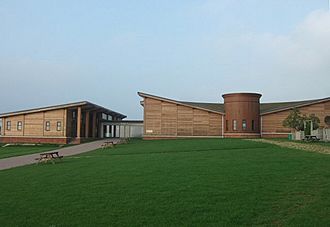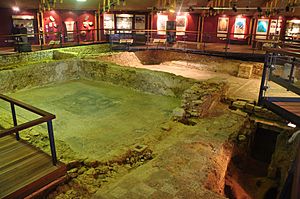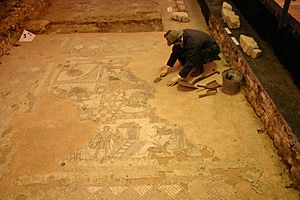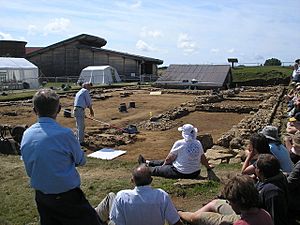Brading Roman Villa facts for kids
Quick facts for kids Brading Roman Villa |
|
|---|---|

Site museum housing the mosaics and walls
|
|
| General information | |
| Location | Brading grid reference SZ598862 |
| Country | United Kingdom |
| Coordinates | 50°40′22″N 1°09′16″W / 50.6728°N 1.1544°W |
| Construction started | 1st century |
| Demolished | 4th century |
Brading Roman Villa is an ancient Roman house on the Isle of Wight. It was once a large farm and home. Today, you can visit its amazing ruins and see beautiful mosaic floors. These floors tell stories about Roman life and beliefs.
Contents
Welcome to Brading Roman Villa!
Brading Roman Villa was a big Roman country house. It had a central courtyard and many rooms. People lived and worked here for hundreds of years. Now, its excavated remains are open for everyone to explore.
How the Villa Was Found
Imagine finding a hidden treasure! In 1879, a farmer named Mr. Munns was digging holes. He was making a pen for his sheep. Suddenly, his tool hit something hard. It was a buried mosaic floor!
The next day, Captain Thorp helped Mr. Munns. They uncovered a special mosaic panel. By spring 1880, half of the villa was dug up. The other half was on a different family's land. Lady Louisa Oglander bought that land. This allowed the excavations to continue.
For many years, the Oglander family let people visit. In 1994, a charity took over the site. They added a visitor centre, a shop, and a cafe. In 2004, the main building covering the ruins was replaced. The visitor facilities were also improved. Behind the villa, there is a small grassy amphitheatre. It was made from soil dug up during the building work.
In August 2008, the University of Oxford started new digs. They hoped to find even more amazing mosaics.
A Look Back in Time: Villa History
The Roman army, led by Vespasian, took over the Isle of Wight in AD 44. The first simple house at Brading was built around the mid-1st century. Over the next 100 years, it grew into a huge and impressive stone villa. It had three sides built around a central courtyard. Its fancy rooms featured many beautiful Roman mosaics.
Around AD 340, the villa faced problems. Pirates often raided estates in southern Britain. Despite a big fire in the 3rd century, the villa was still used for farming. Roman coins found here show people lived at Brading until AD 395. This was when Emperor Honorius began his rule. The villa was then used to store grain for some time. It finally fell apart in the 5th century. Over time, plants covered the site. People forgot where Brading Roman Villa was until its rediscovery.
Life at the Villa: What Was It Like?
The villa's excavated rooms are now protected. They are inside the Exhibition and Visitor Centre. All 12 ground-floor rooms survived. We don't know what every room was used for. The biggest room had a beautiful mosaic floor. It might have been used for parties and entertaining guests. There is no sign of an indoor kitchen. Food might have been cooked outside to prevent fires. Items found in the house show a high standard of living. Things like fancy pottery, jewelry, and games were discovered.
Amazing Mosaics and Their Stories
Five rooms in the main villa house have mosaics. These mosaics show different pictures. They tell us the owners were wealthy and educated. Some show geometric patterns. One mosaic features Orpheus, a famous musician from Greek myths. Another shows Bacchus, the Roman god of wine. It also has a strange cockerel-headed man, gladiators, and a dome-shaped building. The largest mosaic is in two parts. It displays Roman gods, goddesses, Medusa, and scenes of farming and the sea.
The Mystery of the Cockerel-Headed Man
The cockerel-headed man is a very unique part of the mosaics. This mosaic shows him next to a building with steps. Two mythical creatures called griffins are also nearby.
Some people thought he was a special god called Abraxas. But Abraxas usually has a snake's tail too, which this figure does not. Another idea is that the figure makes fun of a gladiator. His name might have been "Gallus," which means "cockerel" in Latin. Some even thought it was a joke about an emperor named Constantius Gallus. Mosaics at Brading are similar to others from Antioch. One idea is that a man named Palladius made them. He was sent to Britain and might have used the mosaic to mock someone who had treated him badly. A simpler idea is that it's just a fantasy animal. It's like other dog-headed figures found in ancient art.
Other Buildings and Gardens
On the north side of the main villa, there are remains of a farmhouse. Workers probably lived here. It had a hypocaust, which was an ancient Roman underfloor heating system. There was also a well. On the south side, there were farm buildings. These included a granary for storing grain and other storerooms. Sadly, these buildings do not exist today.
There is no proof of a formal Roman garden at the site. However, a water feature called a nymphaeum was found outside the villa. It is now shown in the Exhibition Centre. A recreated Roman garden has been planted on the grounds. It has many plants, herbs, and flowers that grew in Roman times.





